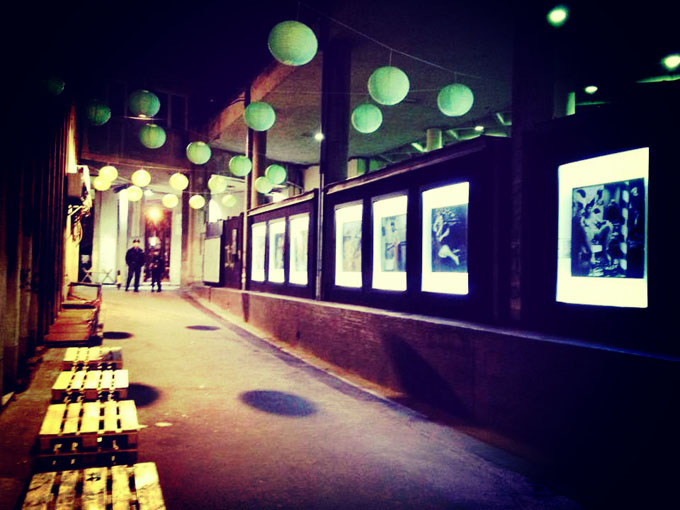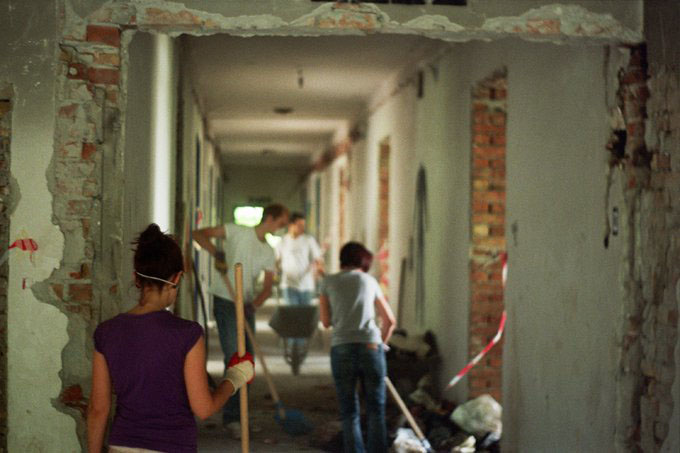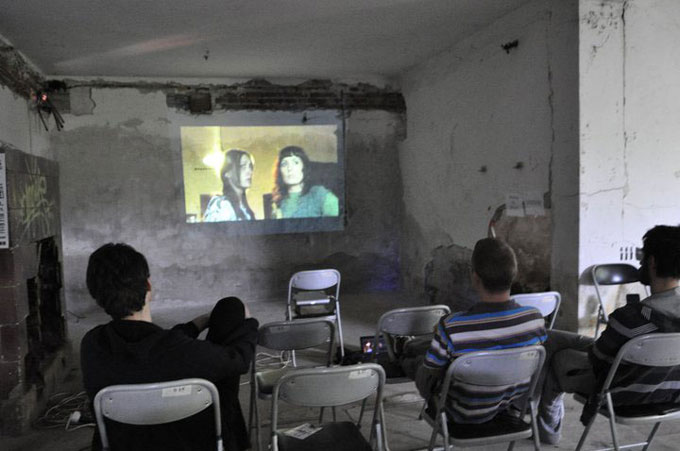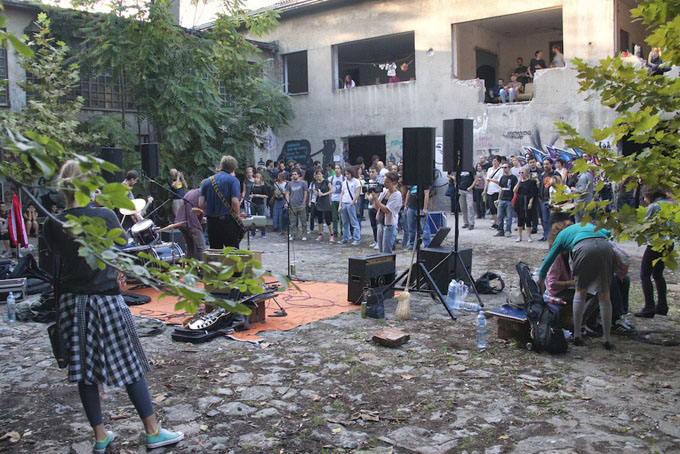
Street Gallery Belgrade. Photo courtesy of the Ministry of Space.
This summer I arrived in Belgrade at the apex of two critical events in the Serbian capital: Europe’s current refugee crisis and a growing protest movement against an impending waterfront construction in the heart of the city. With the help of Miroslav Karic, who runs the renowned Remont Gallery, I met with several artists, many of whom were dealing with the city’s struggles head on.
One of those was Radomir Lazović, a co-founder of the Ministry of Space, an art collective working in and around Belgrade. In this month’s Editor’s Letter, which was made possible with a generous grant from the Trust for Mutual Understanding, I talk to Lazović about the driving force behind establishing the group and what he hopes their work can achieve in the years to come.
Creative Time Reports (Marisa Mazria Katz, editor): What is the Ministry of Space?
Radomir Lazović: The Ministry of Space is a collective of five people that has been active for more than four years in Belgrade. Through a series of actions in public spaces, we strive to draw attention to the problems in our cities as well as to offer viable and creative solutions to those problems. Some of our actions are on the verge of illegality; others are a product of prolonged bureaucratic and technological struggles. The Ministry of Space collective was born out of these struggles.
CTR: When did the project first emerge?
RL: It all began in 2010, when we created the Street Gallery, which is located in a busy part of the city that is considered one of the main commercial passages. It was essentially a dark urban urinal until we took over and reconstructed it into a gallery, a nine-panel space that exhibits photographs, illustrations and all kinds of large-format artworks. The whole process of turning it into a gallery took two years, from the first illegal exhibition in 2010 to the official opening in April 2012.
CTR: Similar to the Street Gallery, you took on the transformation of a former film studio, a project you call Expedition Inex Film (EIF).
RL: This was a project that involved dozens of people. It centered on an abandoned building in a suburb of Belgrade called Karaburma that once housed a film production house. We occupied the building with 40 artists. It was a really run-down building with no windows, doors, floors or furniture. It took us months to clean it out. We didn’t know what it would be in the beginning, but today you can find several art studios, a gallery, a dance studio and a contemporary circus that all developed their work in that space.

Expedition Inex Film. Photo courtesy of the Ministry of Space.
CTR: What kind of needs does the collective aim to fulfill?
RL: At the beginning our activities were close to the Right to the City movement. We were mostly involved in struggles concerning occupations of spaces for cultural production, since we come from a cultural field. But from the start we were aware that these struggles are connected with the fights for other public goods or public goods in general, such as the right to water or the fight against commercialization of public space. Artists need new spaces for production, working and exhibiting, but more than that we all need spaces of freedom, solidarity and joint work. The institutional cultural scene in Serbia, like the whole of the society, is highly politicized. It is conservative and corrupt, and unable to fulfill the needs of artists or cultural audiences. It was because of this situation that we felt, and feel, the need to create spaces that have all these components. Basically it was a kind of protest against the situation in culture, a situation that still hasn’t changed.
I feel that culture is a public good and as such should not be dependent only on the market, and the same with education or housing.
On the one hand, you have a really bad institutional situation, and on the other, you have a government with a tendency to completely cut down cultural funding and use the bad institutional situation as an excuse to present culture as an unnecessary expense. For example, just a few years ago the cultural budget was only 0.62 percent of the whole budget. In that framework the independent cultural organizations are trying to work and present some innovative practices and alternative solutions for sustainable production.
CTR: Do you think it is a matter of artists getting involved in politics to change things like funding? Or is the aim to make sure that the arts get the attention of the people who can eventually make the changes you seek? What is the best approach?
RL: I think that it is much more than the question of funding. It is the possibility of influencing values and supporting or developing people’s critical thinking. I support politically engaged art because of this. For me the independent art scene is sort of a protest movement against the neoliberal tendencies that are happening in the cultural sphere. I feel that culture is a public good and as such should not be dependent only on the market, and the same with education or housing. For example, in Belgrade we have 14 cinemas that were abandoned because of corrupt privatization. The new owner found it much more lucrative to have a supermarket or casino in those places, and the state didn’t do anything to prevent this. I really don’t see how else you can confront this kind of destruction of cultural fabric in the city, and the country, if you don’t organize yourself politically.
CTR: In response to the 14 cinemas closing, you created the project Cinemas: The Written Off Return. Can you talk about the project and the impact it had in Belgrade?
RL: The Cinemas: The Written Off Return campaign is a series of site-specific urban installations made with the idea of raising awareness about the closing of a large number of Belgrade cinemas. The project managed to captivate the public’s attention for two years. In that time we were building a case against the closures. In the end we occupied one of the cinemas, which is now still open as an art house cinema where a group of artists show movies and organize discussions and other programs. But as with any space, in our opinion, you have to be aware that only showing movies, playing concerts or having exhibitions is not enough. It can end up being just another place to go out. I don’t feel culture should be only a place to have fun and entertain oneself. It should be a critical space where you can question the relations that we have with one another, with the system and within ourselves.

Expedition Inex Film. Photo courtesy of the Ministry of Space.
CTR: Regarding the cinema campaign, you have asked, “Does the society want to save its own interests [in this area] in a world economy context, and if it does, in what way?” Do you now feel that you have been able to answer that question?
RL: Do we as a society have the right to make some sort of agreement among ourselves? Do we believe that we can take culture out of the market? Do we believe that we can take water off the market or housing rights off the market? I don’t know. In this neoliberal system we don’t have any rights to make any deals because the market is like God. But I don’t feel that way. I feel that we as a society can say what we want to preserve and in what way. Basically for me the battle for culture—and it is a battle in this situation—is a battle for public good. We feel that culture is a public good, and it should be taken out of the market and preserved as a public good.
CTR: I want to bring up how you have been reacting, as Ministry of Space, to a large proposed waterfront project that will see foreign investors along with the government taking over a large part of Belgrade. Is the Ministry of Space taking a position on this project?
RL: Yes, the Ministry of Space is an active member of the protest group called Let’s Not Drown Belgrade. We are a group of around 30 people with various profiles, interests and beliefs, gathered around a common goal: putting an end to the degradation and plunder of Belgrade on behalf of megalomaniacal urban and architectural projects, primarily the Belgrade waterfront project. We are focused mainly on encouraging citizens to join the campaign and confront this nontransparent and corrupt city development through protests and other guerrilla actions. We also monitor and analyze the project phase by phase and take note of any violations. All the criticism—that the whole deal is contrary to Serbian law and procedures, that it does not take into account the needs of the society or economic and urban reality and that the cost of clearing the land is too expensive for an already impoverished country—was answered with projections from the city representatives as well as the prime minister that the project will boost the faltering construction industry and furthermore the whole economy. But there is no information about what it will cost Belgrade. I am certain that there will be no benefit for the citizens, no benefit for the overall budget.
CTR: How does art play a role in this crisis? What can art do that is different, say, than what an NGO does?
RL: Many of those who have organized the initiative are individuals who come from the independent art scene, artists or cultural managers. Additionally, there was no lustration after the Milosevic regime. At that time people expected a lot, but it seemed that power stayed in the hands of many from the regime. The narrative might have changed, but the essence stayed the same. Big words like democracy, transparency, citizen participation, European Union were used a lot but without actual meaning, just for marketing purposes. It is the same milieu of tycoons, businessmen and politicians in the same place where they were before. That kind of elite is leading the country into a complete mess—into a corrupt neoliberal society where you don’t have any space for the common people. People are fed up with this.
I don’t feel culture should be only a place to have fun and entertain oneself. It should be a critical space where you can question the relations that we have with one another, with the system and within ourselves.
What we see is that culture in this kind of highly traumatized society can bring a new kind of critique, a new kind of rethinking of the system and of life itself. It can really unmask what is happening around us. Cinemas: The Written Off Return is a really good campaign because we concentrated on urban interventions; we never sent any emails to the press saying, “Look, privatization is bad.” What we did was make a strong urban intervention that got journalists to write about problems that were obvious.
Think about it: 14 cinemas in Belgrade were closed just like that. Even for New York City that would be a big number. Through our urban intervention we asked: How is it that in just one year someone can change the essence of these spaces, turning them from cinemas into casinos or supermarkets? How did we let that happen? Reporters started to write about it. Hopefully it will show that the citizens will not allow these kinds of things to happen.

Cinemas: The Written Off Return. Photo by Saša-Čolić. © Kamerades.
CTR: What does the next year look like for the Ministry of Space?
RL: Currently we are organizing the Trans-Europa Festival, which will bring more than 70 presenters from all over Europe. Its main objective is to make a temporary space for people to exchange, co-create and find common ground for future actions to call for democracy, equality and culture beyond the nation-state. The festival program is divided into four themes: new forms of politics and movements, mobility and migrations, alternative economies and the commons. Contributors include artists, activists and leading thinkers, such as the philosopher Srećko Horvat, the political scientist Ulrike Guérot, the activist and Pirate Bay co-founder Peter Sunde, the author and activist Brett Scott, the theater director Angela Richter and the Guardian journalist Nabeelah Shabbir.
We plan to continue with our current actions confronting the waterfront development project. In this next round we want to broaden the “front” against this damaging government deal, and we plan to stage huge protests before they start to break ground.
CTR: During my visit I was informed that the Museum of Contemporary Art in Belgrade was empty. What is happening with that and what can the Ministry of Space do? Can you occupy it in the same way you did with Expedition Inex Film?
RL: You know what is on top of this museum? There is a clock that is counting down to the time when it will be open. The big date is October 20. But even after several years of reconstruction, and several attempts to renovate and reopen the museum, it is still closed. It is a scandal, and nobody is answering for this situation. If we let this happen, we will end up in a society in which it is normal for the museums to be closed, and the need for them will be lost. Cultural needs have to be nourished. I am not announcing plans for specific actions right now, but I hope that a critical mass will emerge on the art scene that will pressure the government to solve this problem.

Expedition Inex Film. Photo courtesy of the Ministry of Space.

